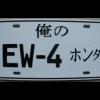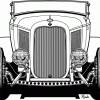I have been studying the Kakabox Build and I have a good idea of how I will design my braces. I expect to tie into all four of the bolts holding the doors to the chassis, run the forward "arm" at least as far forward and tie it in at the end and somewhere in the center as well. The critical element is the 45 degree triangulation to give the arm its rigidity. And I am probably going to add a piece to strengthen the connection between the down tube and forward arm in the corner.
The Kakabox Build uses steel box tubing. I am leaning toward using aluminum, largely because the chop saw I have access to does not have a carbine blade
Installing fender braces means removing the old fenders which are being held together only by packing tape. I suppose this is the right time to get a set of decent new fenders. I could just lay some fiberglass on the inside of the OEM-style fenders for extra strength.... but how cool would it be if I could source some CF fenders?
But before I start the Fender Brace project.... I am working up my courage to drop the rear axle and install a set of new swing arm bushings. I will get that done during Spring Break (yeah, I am taking a Spring Break this year).
Maybe I will have the car all done by the time Doug has his Mid-State affair in Bakersfield.
Scott
 Sign In
Sign In Create Account
Create Account





 Back to top
Back to top

 View Garage
View Garage













